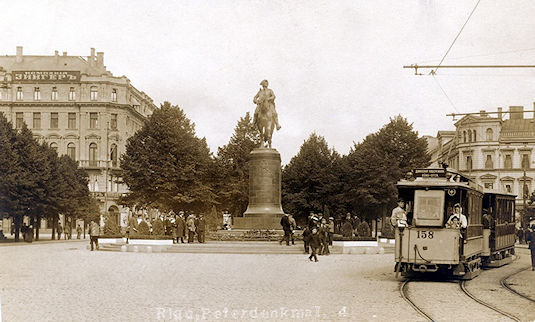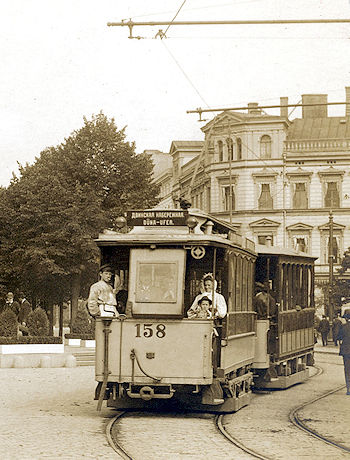

Riga is the capital and largest city of Latvia and is home to over 600,000 inhabitants, which is about a third of Latvia's population. Riga was founded in 1201 and is a former Hanseatic League member. Riga's historical centre is a UNESCO World Heritage Site, noted for its Art Nouveau architecture and 19th century wooden architecture. The city lies on the Gulf of Riga at the mouth of the Daugava river where it meets the Baltic Sea.
Since the break-up of the Soviet Union in 1990, Latvia has been an independent republic and is now an EU member state. Prior to that, Riga and much or most of present-day Latvia fell under various jurisdictions. It was part of the Swedish Empire (1629-1721), the Russian Empire (1721-1917), the German Empire (1917-1918) and was the Republic of Latvia from 1918 to 1940 when it became part of the Soviet Union in 1940-1941. From 1941 to 1944 it was occupied by Nazi Germany but was retaken by the Soviet Union in 1944 until 1990.
On 23 August 1882 the first horse tram line was opened in Riga using 95 horses. From 1900 the network was electrified by the Riga Tram Company. After Liepaja (Libau), Riga has the second oldest electric tram network in the Baltic States. The first electrically operated line ran on Alexanderstrasse from July 1901. From 1901 to 1914, nine new lines with a total length of around 50 kilometres were opened and, by 1914, the tramway had 16 routes. The year before, over 50 million passengers were carried.
Within a few years of the electric tramway opening, there were well over 100 trams, all of the same or closely similar design and manufacture. Most or all of the trams of this period are believed to have been built locally. It would appear that numbering of the early electric fleet started at 100 or 101 and by about 1910, the system had expanded such that over 200 trams were required.
 Our postcard shows tram 158, with trailer, briefly stopping to allow the photographer (from Millen & Co. of Riga) to record the scene. The new statue, at picture centre, of Peter the Great in Riga was unveiled in 1910 and is being admired by many people. The statue was removed by the Russians in 1916 and was being taken to Russia for melting down to make bullets but the ship carrying it was sunk off the Estonian coast. In about 1930, the statue was recovered undamaged and is on display elsewhere in Riga. On this site today stands the 'Freedom Monument' unveiled in 1935.
Our postcard shows tram 158, with trailer, briefly stopping to allow the photographer (from Millen & Co. of Riga) to record the scene. The new statue, at picture centre, of Peter the Great in Riga was unveiled in 1910 and is being admired by many people. The statue was removed by the Russians in 1916 and was being taken to Russia for melting down to make bullets but the ship carrying it was sunk off the Estonian coast. In about 1930, the statue was recovered undamaged and is on display elsewhere in Riga. On this site today stands the 'Freedom Monument' unveiled in 1935.
An enlargement from the above postcard (left) focusses on tram 158 with its trailer. The driver can just be seen behind the primitive windscreen but note the family group standing on the front platform to the right. We have an elegantly dressed mother with a young son (with hat) in front of her and in front of him a still younger sibling can only just see over the top of the dash. The tram is going to 'Düna - Ufer' (the nearby riverbank). Tram destination boards were bilingual at this time - in Russian and German.
Tramway patronage fell after the First World War and by 1928 there were nine routes carrying 48 million passengers. After the Second World War, the situation remained much the same but, in the 1950s and 1960s, trams were increasingly replaced by buses and trolleybuses. The decline lasted until the 1980s but ended with the opening of a new line to Imanta in 1984. Since then, the tramway system has consolidated and a fleet of modern articulated trams by Skoda has started to replace some of the post-war Tatra rolling stock. Riga is one of the very few European cities that still uses trolley-poles on its trams, at least on its older Tatra stock, although the newer Skoda fleet is fitted with one-arm pantographs. Additionally, some bi-modal (hydrogen range-extended) trolleybuses have been running in the city since 2020. The hydrogen fuel-cells allow the (trolley-)bus to drive up to 150km without wires. Overall, the outlook for electric traction in Riga is assured for many years to come.
![]() Go to Postcard Of The Month Index
Go to Postcard Of The Month Index